Report on Zara's Business Environment and Organizational Functions
VerifiedAdded on 2020/10/05
|13
|3950
|432
Report
AI Summary
This report provides a comprehensive analysis of Zara's business environment, organizational structure, and key functions. It begins with an introduction to business organizations, differentiating between private, public, and voluntary sectors, and explores various legal structures. The report then delves into the size and scope of different organizations, using Zara as a primary case study to exemplify a private sector entity. It examines the interrelation of organizational functions such as HR, finance, operations, and marketing, and how these functions contribute to achieving business objectives. The report further assesses the impact of the macro environment on business operations, discussing both positive and negative influences. Finally, it explores internal and external analysis, including the interrelation of strengths and weaknesses with external macro factors, to provide a holistic understanding of Zara's business strategy and environment. The report emphasizes Zara's divisional structure and its flat organizational format as key factors in its global success.
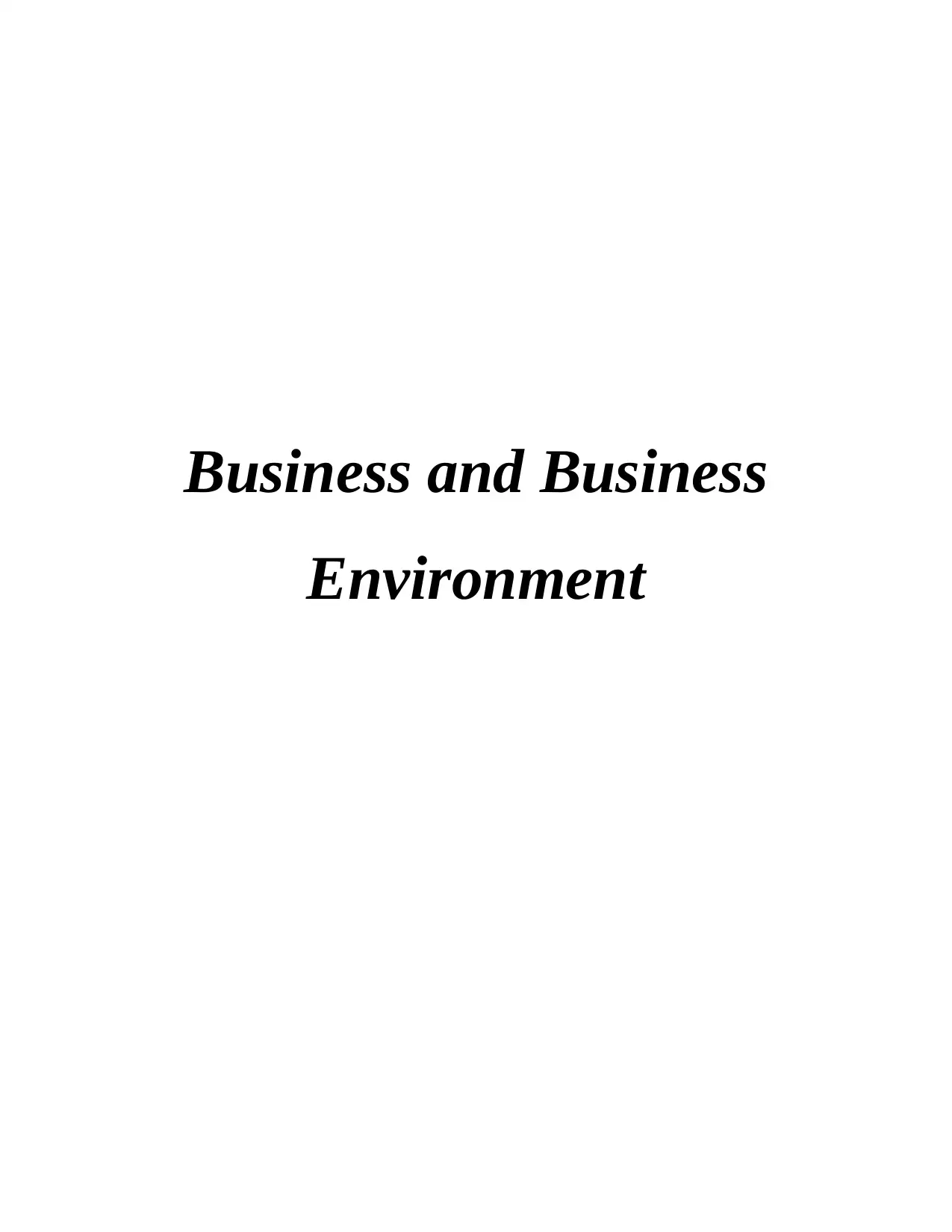
Business and Business
Environment
Environment
Paraphrase This Document
Need a fresh take? Get an instant paraphrase of this document with our AI Paraphraser
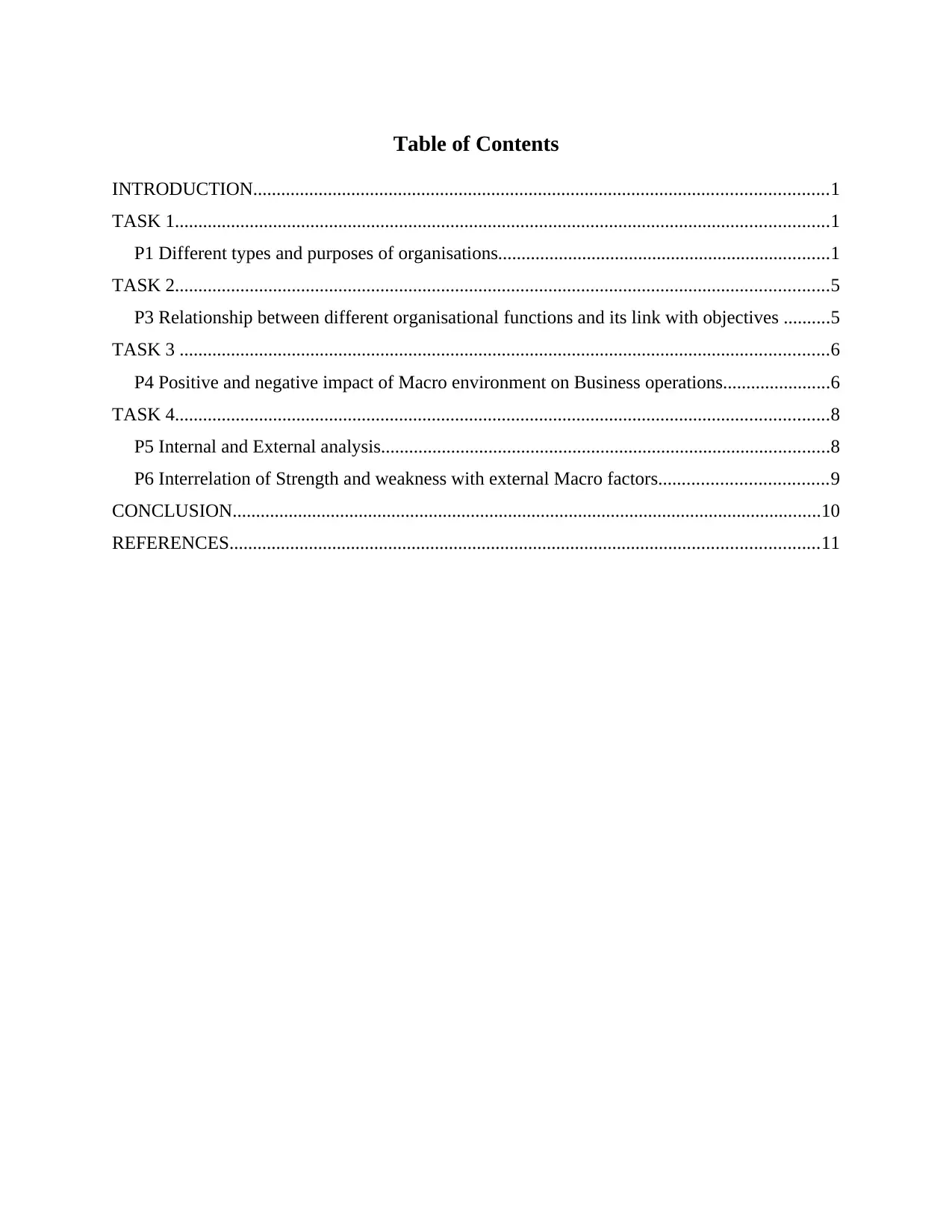
Table of Contents
INTRODUCTION...........................................................................................................................1
TASK 1............................................................................................................................................1
P1 Different types and purposes of organisations.......................................................................1
TASK 2............................................................................................................................................5
P3 Relationship between different organisational functions and its link with objectives ..........5
TASK 3 ...........................................................................................................................................6
P4 Positive and negative impact of Macro environment on Business operations.......................6
TASK 4............................................................................................................................................8
P5 Internal and External analysis................................................................................................8
P6 Interrelation of Strength and weakness with external Macro factors....................................9
CONCLUSION..............................................................................................................................10
REFERENCES..............................................................................................................................11
INTRODUCTION...........................................................................................................................1
TASK 1............................................................................................................................................1
P1 Different types and purposes of organisations.......................................................................1
TASK 2............................................................................................................................................5
P3 Relationship between different organisational functions and its link with objectives ..........5
TASK 3 ...........................................................................................................................................6
P4 Positive and negative impact of Macro environment on Business operations.......................6
TASK 4............................................................................................................................................8
P5 Internal and External analysis................................................................................................8
P6 Interrelation of Strength and weakness with external Macro factors....................................9
CONCLUSION..............................................................................................................................10
REFERENCES..............................................................................................................................11
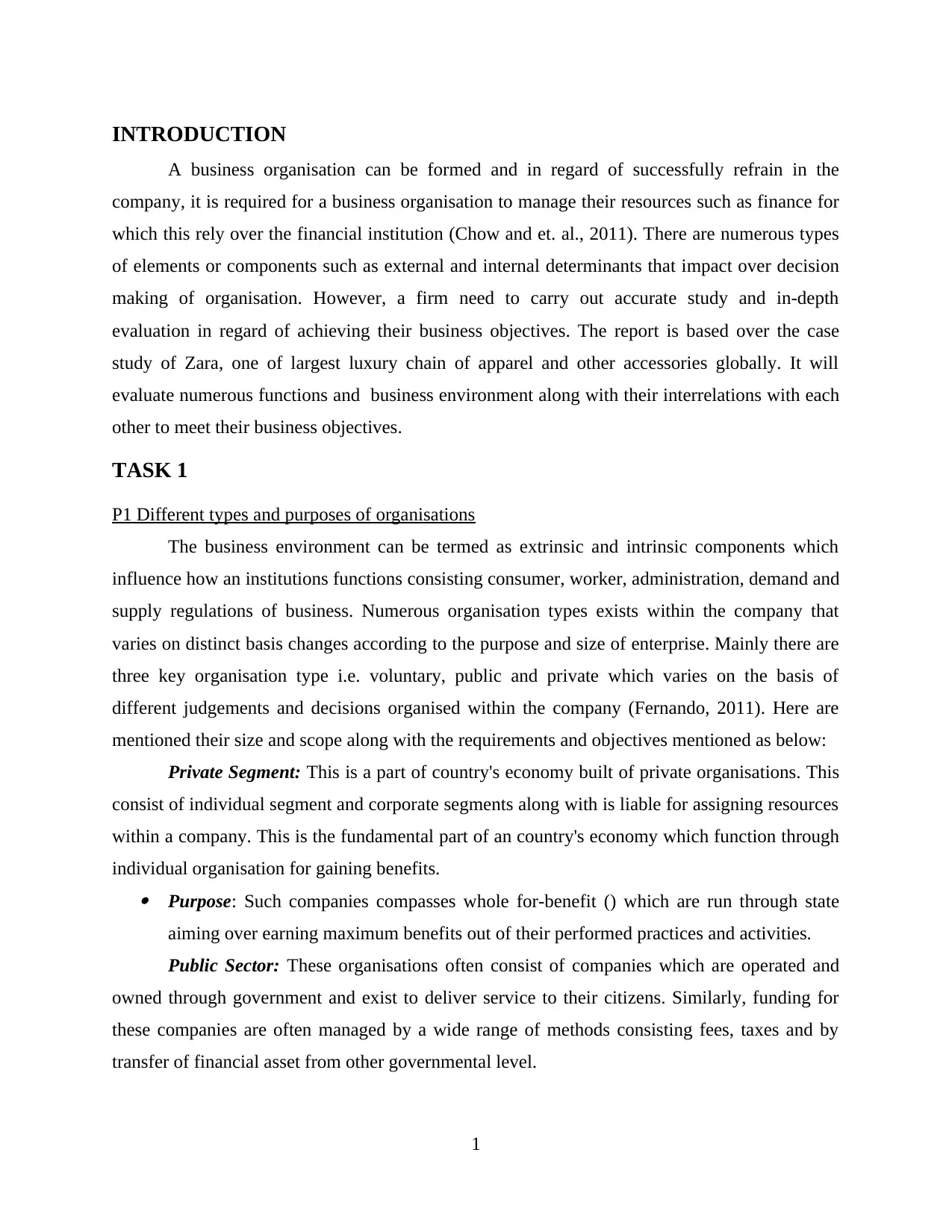
INTRODUCTION
A business organisation can be formed and in regard of successfully refrain in the
company, it is required for a business organisation to manage their resources such as finance for
which this rely over the financial institution (Chow and et. al., 2011). There are numerous types
of elements or components such as external and internal determinants that impact over decision
making of organisation. However, a firm need to carry out accurate study and in-depth
evaluation in regard of achieving their business objectives. The report is based over the case
study of Zara, one of largest luxury chain of apparel and other accessories globally. It will
evaluate numerous functions and business environment along with their interrelations with each
other to meet their business objectives.
TASK 1
P1 Different types and purposes of organisations
The business environment can be termed as extrinsic and intrinsic components which
influence how an institutions functions consisting consumer, worker, administration, demand and
supply regulations of business. Numerous organisation types exists within the company that
varies on distinct basis changes according to the purpose and size of enterprise. Mainly there are
three key organisation type i.e. voluntary, public and private which varies on the basis of
different judgements and decisions organised within the company (Fernando, 2011). Here are
mentioned their size and scope along with the requirements and objectives mentioned as below:
Private Segment: This is a part of country's economy built of private organisations. This
consist of individual segment and corporate segments along with is liable for assigning resources
within a company. This is the fundamental part of an country's economy which function through
individual organisation for gaining benefits. Purpose: Such companies compasses whole for-benefit () which are run through state
aiming over earning maximum benefits out of their performed practices and activities.
Public Sector: These organisations often consist of companies which are operated and
owned through government and exist to deliver service to their citizens. Similarly, funding for
these companies are often managed by a wide range of methods consisting fees, taxes and by
transfer of financial asset from other governmental level.
1
A business organisation can be formed and in regard of successfully refrain in the
company, it is required for a business organisation to manage their resources such as finance for
which this rely over the financial institution (Chow and et. al., 2011). There are numerous types
of elements or components such as external and internal determinants that impact over decision
making of organisation. However, a firm need to carry out accurate study and in-depth
evaluation in regard of achieving their business objectives. The report is based over the case
study of Zara, one of largest luxury chain of apparel and other accessories globally. It will
evaluate numerous functions and business environment along with their interrelations with each
other to meet their business objectives.
TASK 1
P1 Different types and purposes of organisations
The business environment can be termed as extrinsic and intrinsic components which
influence how an institutions functions consisting consumer, worker, administration, demand and
supply regulations of business. Numerous organisation types exists within the company that
varies on distinct basis changes according to the purpose and size of enterprise. Mainly there are
three key organisation type i.e. voluntary, public and private which varies on the basis of
different judgements and decisions organised within the company (Fernando, 2011). Here are
mentioned their size and scope along with the requirements and objectives mentioned as below:
Private Segment: This is a part of country's economy built of private organisations. This
consist of individual segment and corporate segments along with is liable for assigning resources
within a company. This is the fundamental part of an country's economy which function through
individual organisation for gaining benefits. Purpose: Such companies compasses whole for-benefit () which are run through state
aiming over earning maximum benefits out of their performed practices and activities.
Public Sector: These organisations often consist of companies which are operated and
owned through government and exist to deliver service to their citizens. Similarly, funding for
these companies are often managed by a wide range of methods consisting fees, taxes and by
transfer of financial asset from other governmental level.
1
⊘ This is a preview!⊘
Do you want full access?
Subscribe today to unlock all pages.

Trusted by 1+ million students worldwide
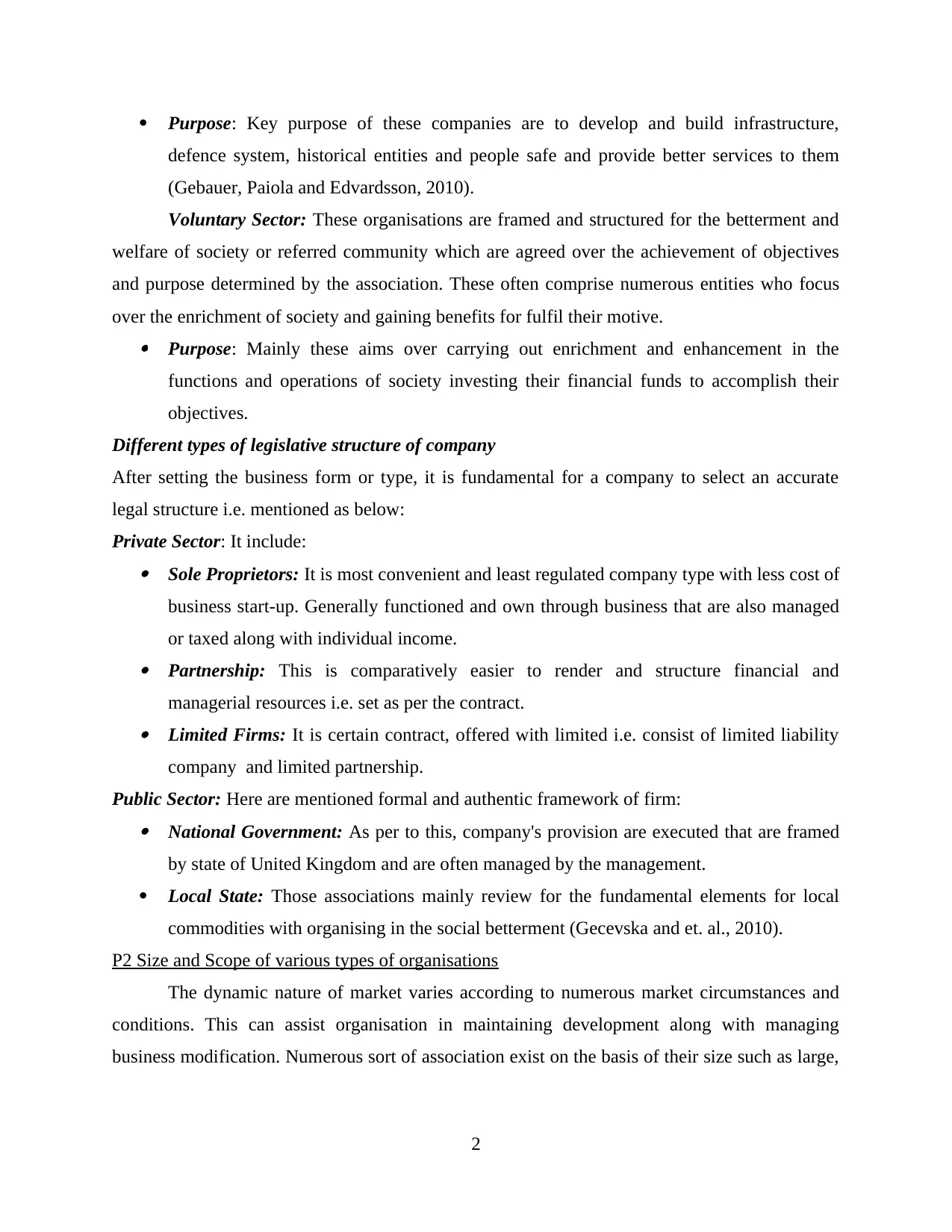
Purpose: Key purpose of these companies are to develop and build infrastructure,
defence system, historical entities and people safe and provide better services to them
(Gebauer, Paiola and Edvardsson, 2010).
Voluntary Sector: These organisations are framed and structured for the betterment and
welfare of society or referred community which are agreed over the achievement of objectives
and purpose determined by the association. These often comprise numerous entities who focus
over the enrichment of society and gaining benefits for fulfil their motive. Purpose: Mainly these aims over carrying out enrichment and enhancement in the
functions and operations of society investing their financial funds to accomplish their
objectives.
Different types of legislative structure of company
After setting the business form or type, it is fundamental for a company to select an accurate
legal structure i.e. mentioned as below:
Private Sector: It include: Sole Proprietors: It is most convenient and least regulated company type with less cost of
business start-up. Generally functioned and own through business that are also managed
or taxed along with individual income. Partnership: This is comparatively easier to render and structure financial and
managerial resources i.e. set as per the contract. Limited Firms: It is certain contract, offered with limited i.e. consist of limited liability
company and limited partnership.
Public Sector: Here are mentioned formal and authentic framework of firm: National Government: As per to this, company's provision are executed that are framed
by state of United Kingdom and are often managed by the management.
Local State: Those associations mainly review for the fundamental elements for local
commodities with organising in the social betterment (Gecevska and et. al., 2010).
P2 Size and Scope of various types of organisations
The dynamic nature of market varies according to numerous market circumstances and
conditions. This can assist organisation in maintaining development along with managing
business modification. Numerous sort of association exist on the basis of their size such as large,
2
defence system, historical entities and people safe and provide better services to them
(Gebauer, Paiola and Edvardsson, 2010).
Voluntary Sector: These organisations are framed and structured for the betterment and
welfare of society or referred community which are agreed over the achievement of objectives
and purpose determined by the association. These often comprise numerous entities who focus
over the enrichment of society and gaining benefits for fulfil their motive. Purpose: Mainly these aims over carrying out enrichment and enhancement in the
functions and operations of society investing their financial funds to accomplish their
objectives.
Different types of legislative structure of company
After setting the business form or type, it is fundamental for a company to select an accurate
legal structure i.e. mentioned as below:
Private Sector: It include: Sole Proprietors: It is most convenient and least regulated company type with less cost of
business start-up. Generally functioned and own through business that are also managed
or taxed along with individual income. Partnership: This is comparatively easier to render and structure financial and
managerial resources i.e. set as per the contract. Limited Firms: It is certain contract, offered with limited i.e. consist of limited liability
company and limited partnership.
Public Sector: Here are mentioned formal and authentic framework of firm: National Government: As per to this, company's provision are executed that are framed
by state of United Kingdom and are often managed by the management.
Local State: Those associations mainly review for the fundamental elements for local
commodities with organising in the social betterment (Gecevska and et. al., 2010).
P2 Size and Scope of various types of organisations
The dynamic nature of market varies according to numerous market circumstances and
conditions. This can assist organisation in maintaining development along with managing
business modification. Numerous sort of association exist on the basis of their size such as large,
2
Paraphrase This Document
Need a fresh take? Get an instant paraphrase of this document with our AI Paraphraser
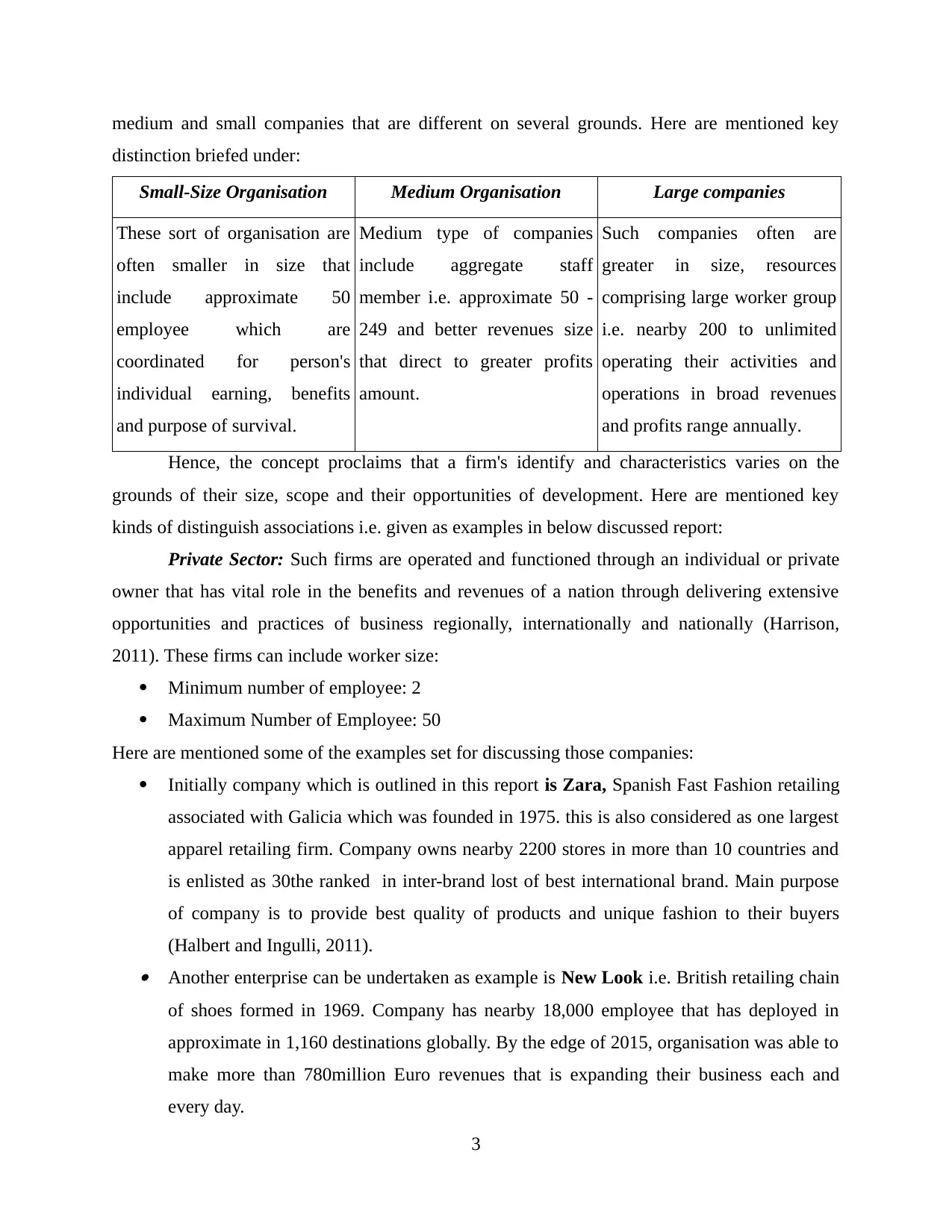
medium and small companies that are different on several grounds. Here are mentioned key
distinction briefed under:
Small-Size Organisation Medium Organisation Large companies
These sort of organisation are
often smaller in size that
include approximate 50
employee which are
coordinated for person's
individual earning, benefits
and purpose of survival.
Medium type of companies
include aggregate staff
member i.e. approximate 50 -
249 and better revenues size
that direct to greater profits
amount.
Such companies often are
greater in size, resources
comprising large worker group
i.e. nearby 200 to unlimited
operating their activities and
operations in broad revenues
and profits range annually.
Hence, the concept proclaims that a firm's identify and characteristics varies on the
grounds of their size, scope and their opportunities of development. Here are mentioned key
kinds of distinguish associations i.e. given as examples in below discussed report:
Private Sector: Such firms are operated and functioned through an individual or private
owner that has vital role in the benefits and revenues of a nation through delivering extensive
opportunities and practices of business regionally, internationally and nationally (Harrison,
2011). These firms can include worker size:
Minimum number of employee: 2
Maximum Number of Employee: 50
Here are mentioned some of the examples set for discussing those companies:
Initially company which is outlined in this report is Zara, Spanish Fast Fashion retailing
associated with Galicia which was founded in 1975. this is also considered as one largest
apparel retailing firm. Company owns nearby 2200 stores in more than 10 countries and
is enlisted as 30the ranked in inter-brand lost of best international brand. Main purpose
of company is to provide best quality of products and unique fashion to their buyers
(Halbert and Ingulli, 2011). Another enterprise can be undertaken as example is New Look i.e. British retailing chain
of shoes formed in 1969. Company has nearby 18,000 employee that has deployed in
approximate in 1,160 destinations globally. By the edge of 2015, organisation was able to
make more than 780million Euro revenues that is expanding their business each and
every day.
3
distinction briefed under:
Small-Size Organisation Medium Organisation Large companies
These sort of organisation are
often smaller in size that
include approximate 50
employee which are
coordinated for person's
individual earning, benefits
and purpose of survival.
Medium type of companies
include aggregate staff
member i.e. approximate 50 -
249 and better revenues size
that direct to greater profits
amount.
Such companies often are
greater in size, resources
comprising large worker group
i.e. nearby 200 to unlimited
operating their activities and
operations in broad revenues
and profits range annually.
Hence, the concept proclaims that a firm's identify and characteristics varies on the
grounds of their size, scope and their opportunities of development. Here are mentioned key
kinds of distinguish associations i.e. given as examples in below discussed report:
Private Sector: Such firms are operated and functioned through an individual or private
owner that has vital role in the benefits and revenues of a nation through delivering extensive
opportunities and practices of business regionally, internationally and nationally (Harrison,
2011). These firms can include worker size:
Minimum number of employee: 2
Maximum Number of Employee: 50
Here are mentioned some of the examples set for discussing those companies:
Initially company which is outlined in this report is Zara, Spanish Fast Fashion retailing
associated with Galicia which was founded in 1975. this is also considered as one largest
apparel retailing firm. Company owns nearby 2200 stores in more than 10 countries and
is enlisted as 30the ranked in inter-brand lost of best international brand. Main purpose
of company is to provide best quality of products and unique fashion to their buyers
(Halbert and Ingulli, 2011). Another enterprise can be undertaken as example is New Look i.e. British retailing chain
of shoes formed in 1969. Company has nearby 18,000 employee that has deployed in
approximate in 1,160 destinations globally. By the edge of 2015, organisation was able to
make more than 780million Euro revenues that is expanding their business each and
every day.
3
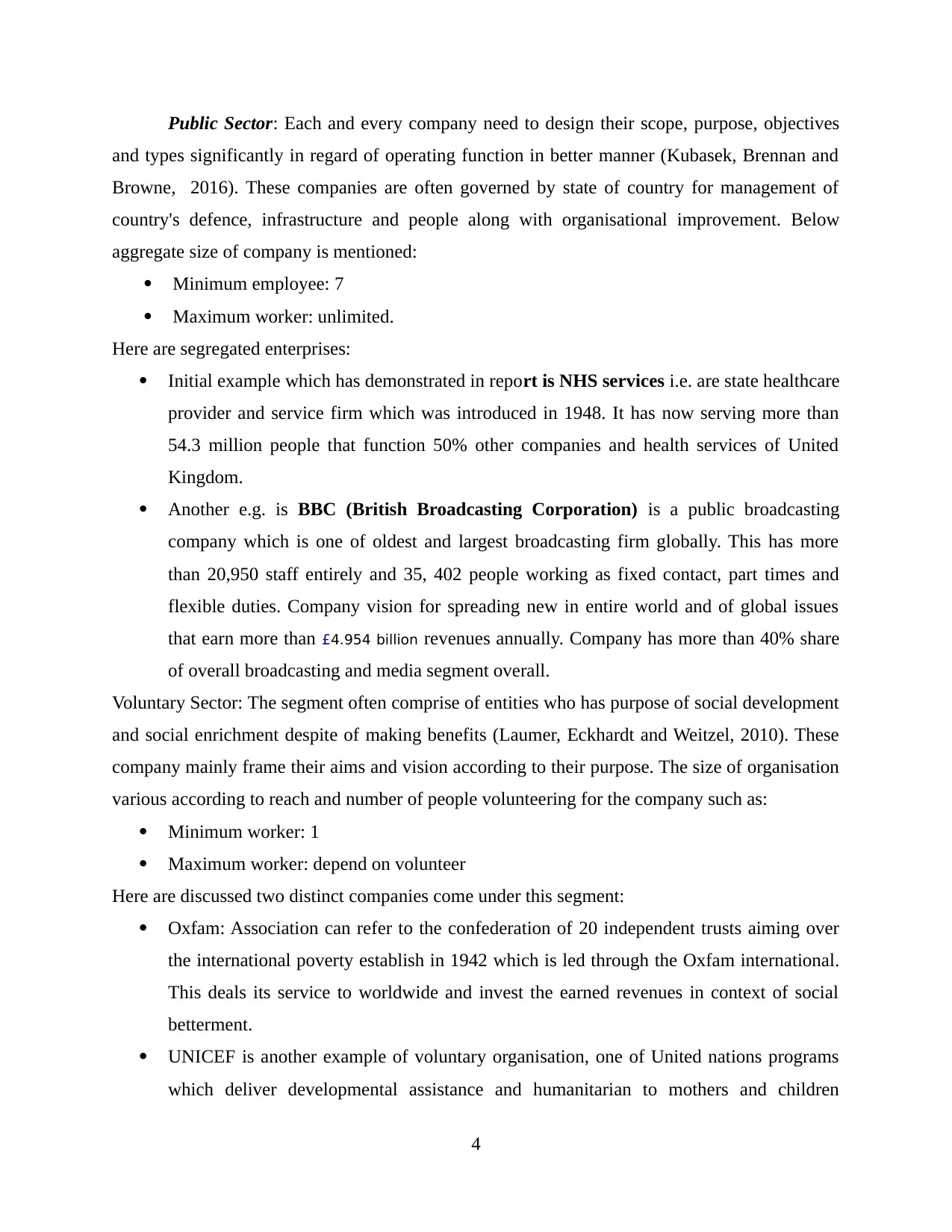
Public Sector: Each and every company need to design their scope, purpose, objectives
and types significantly in regard of operating function in better manner (Kubasek, Brennan and
Browne, 2016). These companies are often governed by state of country for management of
country's defence, infrastructure and people along with organisational improvement. Below
aggregate size of company is mentioned:
Minimum employee: 7
Maximum worker: unlimited.
Here are segregated enterprises:
Initial example which has demonstrated in report is NHS services i.e. are state healthcare
provider and service firm which was introduced in 1948. It has now serving more than
54.3 million people that function 50% other companies and health services of United
Kingdom.
Another e.g. is BBC (British Broadcasting Corporation) is a public broadcasting
company which is one of oldest and largest broadcasting firm globally. This has more
than 20,950 staff entirely and 35, 402 people working as fixed contact, part times and
flexible duties. Company vision for spreading new in entire world and of global issues
that earn more than £4.954 billion revenues annually. Company has more than 40% share
of overall broadcasting and media segment overall.
Voluntary Sector: The segment often comprise of entities who has purpose of social development
and social enrichment despite of making benefits (Laumer, Eckhardt and Weitzel, 2010). These
company mainly frame their aims and vision according to their purpose. The size of organisation
various according to reach and number of people volunteering for the company such as:
Minimum worker: 1
Maximum worker: depend on volunteer
Here are discussed two distinct companies come under this segment:
Oxfam: Association can refer to the confederation of 20 independent trusts aiming over
the international poverty establish in 1942 which is led through the Oxfam international.
This deals its service to worldwide and invest the earned revenues in context of social
betterment.
UNICEF is another example of voluntary organisation, one of United nations programs
which deliver developmental assistance and humanitarian to mothers and children
4
and types significantly in regard of operating function in better manner (Kubasek, Brennan and
Browne, 2016). These companies are often governed by state of country for management of
country's defence, infrastructure and people along with organisational improvement. Below
aggregate size of company is mentioned:
Minimum employee: 7
Maximum worker: unlimited.
Here are segregated enterprises:
Initial example which has demonstrated in report is NHS services i.e. are state healthcare
provider and service firm which was introduced in 1948. It has now serving more than
54.3 million people that function 50% other companies and health services of United
Kingdom.
Another e.g. is BBC (British Broadcasting Corporation) is a public broadcasting
company which is one of oldest and largest broadcasting firm globally. This has more
than 20,950 staff entirely and 35, 402 people working as fixed contact, part times and
flexible duties. Company vision for spreading new in entire world and of global issues
that earn more than £4.954 billion revenues annually. Company has more than 40% share
of overall broadcasting and media segment overall.
Voluntary Sector: The segment often comprise of entities who has purpose of social development
and social enrichment despite of making benefits (Laumer, Eckhardt and Weitzel, 2010). These
company mainly frame their aims and vision according to their purpose. The size of organisation
various according to reach and number of people volunteering for the company such as:
Minimum worker: 1
Maximum worker: depend on volunteer
Here are discussed two distinct companies come under this segment:
Oxfam: Association can refer to the confederation of 20 independent trusts aiming over
the international poverty establish in 1942 which is led through the Oxfam international.
This deals its service to worldwide and invest the earned revenues in context of social
betterment.
UNICEF is another example of voluntary organisation, one of United nations programs
which deliver developmental assistance and humanitarian to mothers and children
4
⊘ This is a preview!⊘
Do you want full access?
Subscribe today to unlock all pages.

Trusted by 1+ million students worldwide
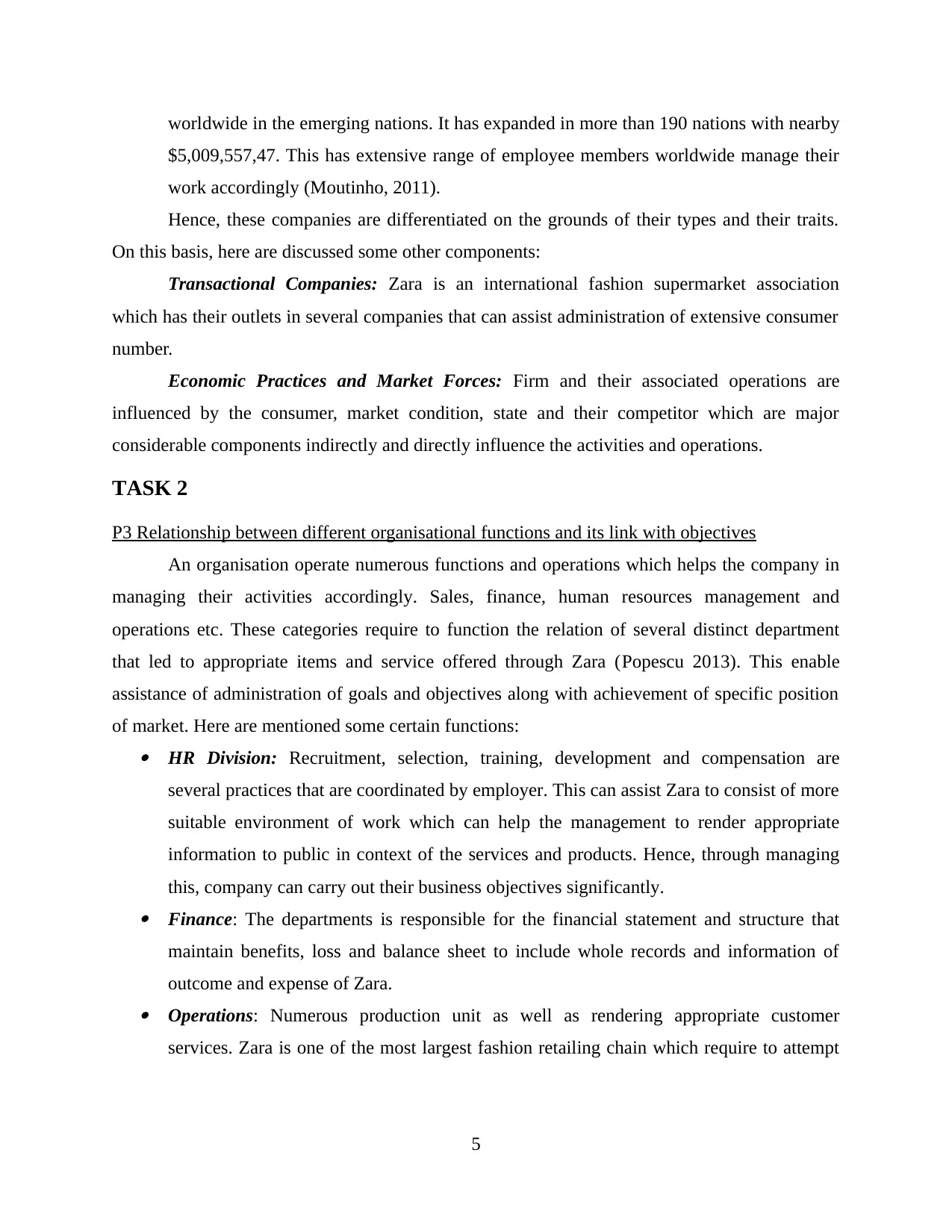
worldwide in the emerging nations. It has expanded in more than 190 nations with nearby
$5,009,557,47. This has extensive range of employee members worldwide manage their
work accordingly (Moutinho, 2011).
Hence, these companies are differentiated on the grounds of their types and their traits.
On this basis, here are discussed some other components:
Transactional Companies: Zara is an international fashion supermarket association
which has their outlets in several companies that can assist administration of extensive consumer
number.
Economic Practices and Market Forces: Firm and their associated operations are
influenced by the consumer, market condition, state and their competitor which are major
considerable components indirectly and directly influence the activities and operations.
TASK 2
P3 Relationship between different organisational functions and its link with objectives
An organisation operate numerous functions and operations which helps the company in
managing their activities accordingly. Sales, finance, human resources management and
operations etc. These categories require to function the relation of several distinct department
that led to appropriate items and service offered through Zara (Popescu 2013). This enable
assistance of administration of goals and objectives along with achievement of specific position
of market. Here are mentioned some certain functions: HR Division: Recruitment, selection, training, development and compensation are
several practices that are coordinated by employer. This can assist Zara to consist of more
suitable environment of work which can help the management to render appropriate
information to public in context of the services and products. Hence, through managing
this, company can carry out their business objectives significantly. Finance: The departments is responsible for the financial statement and structure that
maintain benefits, loss and balance sheet to include whole records and information of
outcome and expense of Zara. Operations: Numerous production unit as well as rendering appropriate customer
services. Zara is one of the most largest fashion retailing chain which require to attempt
5
$5,009,557,47. This has extensive range of employee members worldwide manage their
work accordingly (Moutinho, 2011).
Hence, these companies are differentiated on the grounds of their types and their traits.
On this basis, here are discussed some other components:
Transactional Companies: Zara is an international fashion supermarket association
which has their outlets in several companies that can assist administration of extensive consumer
number.
Economic Practices and Market Forces: Firm and their associated operations are
influenced by the consumer, market condition, state and their competitor which are major
considerable components indirectly and directly influence the activities and operations.
TASK 2
P3 Relationship between different organisational functions and its link with objectives
An organisation operate numerous functions and operations which helps the company in
managing their activities accordingly. Sales, finance, human resources management and
operations etc. These categories require to function the relation of several distinct department
that led to appropriate items and service offered through Zara (Popescu 2013). This enable
assistance of administration of goals and objectives along with achievement of specific position
of market. Here are mentioned some certain functions: HR Division: Recruitment, selection, training, development and compensation are
several practices that are coordinated by employer. This can assist Zara to consist of more
suitable environment of work which can help the management to render appropriate
information to public in context of the services and products. Hence, through managing
this, company can carry out their business objectives significantly. Finance: The departments is responsible for the financial statement and structure that
maintain benefits, loss and balance sheet to include whole records and information of
outcome and expense of Zara. Operations: Numerous production unit as well as rendering appropriate customer
services. Zara is one of the most largest fashion retailing chain which require to attempt
5
Paraphrase This Document
Need a fresh take? Get an instant paraphrase of this document with our AI Paraphraser
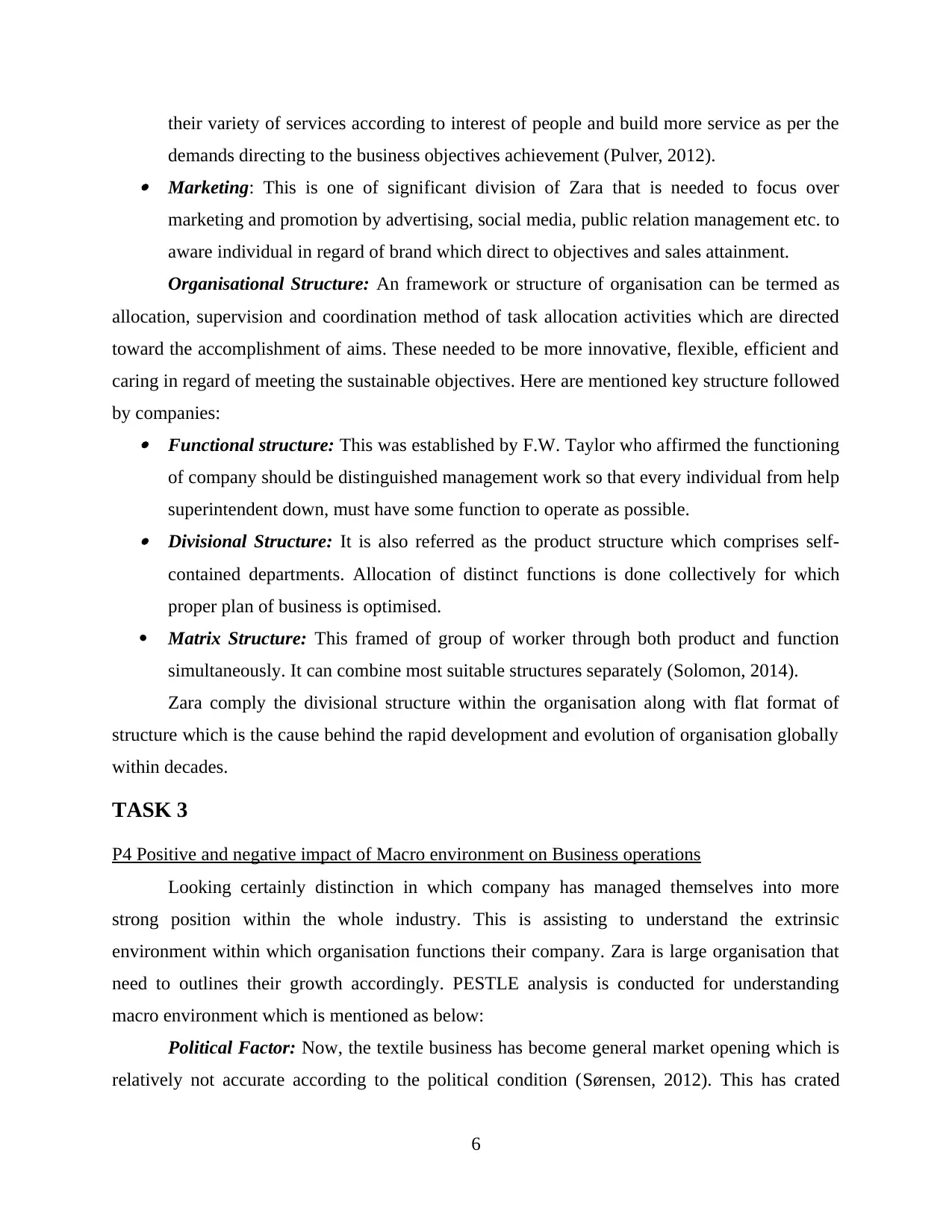
their variety of services according to interest of people and build more service as per the
demands directing to the business objectives achievement (Pulver, 2012). Marketing: This is one of significant division of Zara that is needed to focus over
marketing and promotion by advertising, social media, public relation management etc. to
aware individual in regard of brand which direct to objectives and sales attainment.
Organisational Structure: An framework or structure of organisation can be termed as
allocation, supervision and coordination method of task allocation activities which are directed
toward the accomplishment of aims. These needed to be more innovative, flexible, efficient and
caring in regard of meeting the sustainable objectives. Here are mentioned key structure followed
by companies: Functional structure: This was established by F.W. Taylor who affirmed the functioning
of company should be distinguished management work so that every individual from help
superintendent down, must have some function to operate as possible. Divisional Structure: It is also referred as the product structure which comprises self-
contained departments. Allocation of distinct functions is done collectively for which
proper plan of business is optimised.
Matrix Structure: This framed of group of worker through both product and function
simultaneously. It can combine most suitable structures separately (Solomon, 2014).
Zara comply the divisional structure within the organisation along with flat format of
structure which is the cause behind the rapid development and evolution of organisation globally
within decades.
TASK 3
P4 Positive and negative impact of Macro environment on Business operations
Looking certainly distinction in which company has managed themselves into more
strong position within the whole industry. This is assisting to understand the extrinsic
environment within which organisation functions their company. Zara is large organisation that
need to outlines their growth accordingly. PESTLE analysis is conducted for understanding
macro environment which is mentioned as below:
Political Factor: Now, the textile business has become general market opening which is
relatively not accurate according to the political condition (Sørensen, 2012). This has crated
6
demands directing to the business objectives achievement (Pulver, 2012). Marketing: This is one of significant division of Zara that is needed to focus over
marketing and promotion by advertising, social media, public relation management etc. to
aware individual in regard of brand which direct to objectives and sales attainment.
Organisational Structure: An framework or structure of organisation can be termed as
allocation, supervision and coordination method of task allocation activities which are directed
toward the accomplishment of aims. These needed to be more innovative, flexible, efficient and
caring in regard of meeting the sustainable objectives. Here are mentioned key structure followed
by companies: Functional structure: This was established by F.W. Taylor who affirmed the functioning
of company should be distinguished management work so that every individual from help
superintendent down, must have some function to operate as possible. Divisional Structure: It is also referred as the product structure which comprises self-
contained departments. Allocation of distinct functions is done collectively for which
proper plan of business is optimised.
Matrix Structure: This framed of group of worker through both product and function
simultaneously. It can combine most suitable structures separately (Solomon, 2014).
Zara comply the divisional structure within the organisation along with flat format of
structure which is the cause behind the rapid development and evolution of organisation globally
within decades.
TASK 3
P4 Positive and negative impact of Macro environment on Business operations
Looking certainly distinction in which company has managed themselves into more
strong position within the whole industry. This is assisting to understand the extrinsic
environment within which organisation functions their company. Zara is large organisation that
need to outlines their growth accordingly. PESTLE analysis is conducted for understanding
macro environment which is mentioned as below:
Political Factor: Now, the textile business has become general market opening which is
relatively not accurate according to the political condition (Sørensen, 2012). This has crated
6
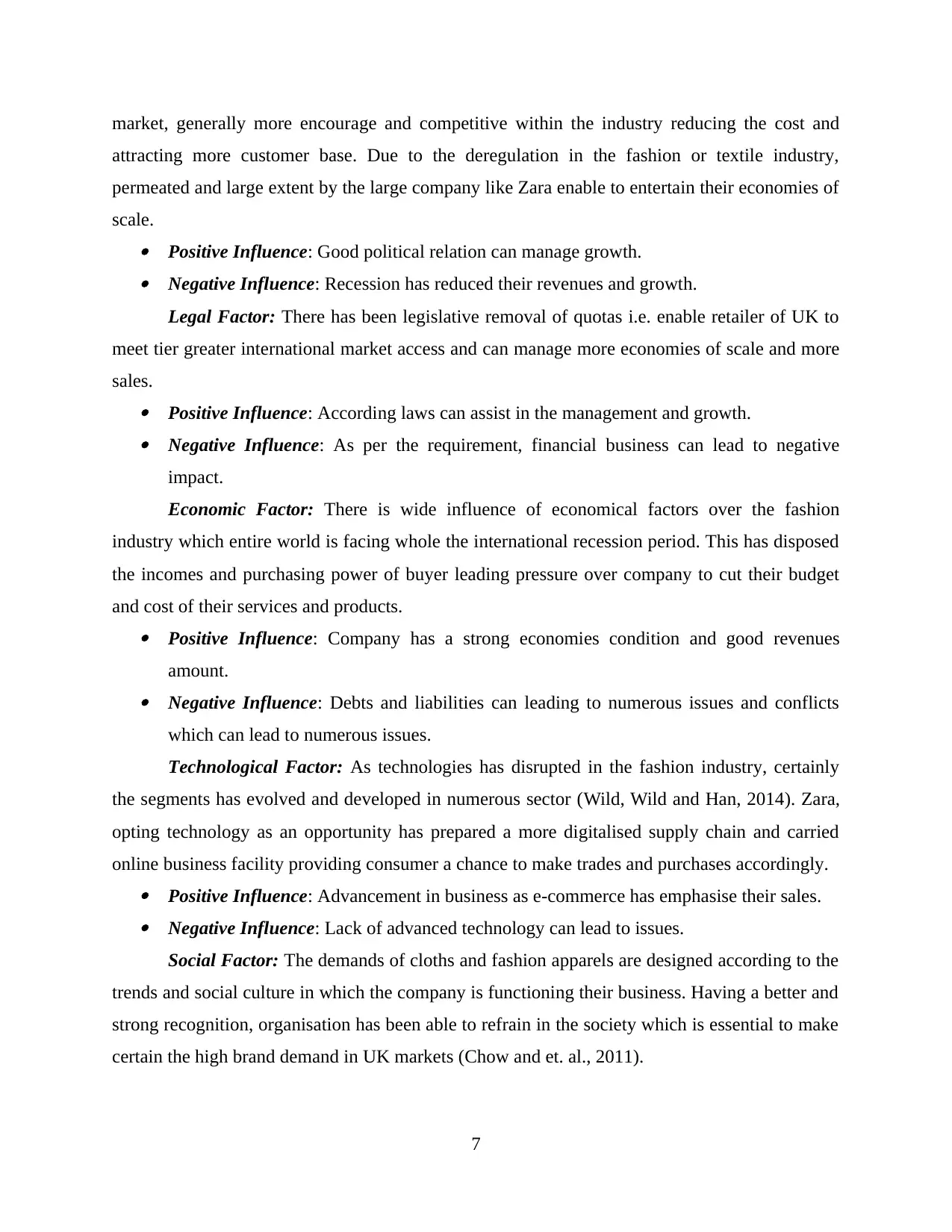
market, generally more encourage and competitive within the industry reducing the cost and
attracting more customer base. Due to the deregulation in the fashion or textile industry,
permeated and large extent by the large company like Zara enable to entertain their economies of
scale. Positive Influence: Good political relation can manage growth. Negative Influence: Recession has reduced their revenues and growth.
Legal Factor: There has been legislative removal of quotas i.e. enable retailer of UK to
meet tier greater international market access and can manage more economies of scale and more
sales. Positive Influence: According laws can assist in the management and growth. Negative Influence: As per the requirement, financial business can lead to negative
impact.
Economic Factor: There is wide influence of economical factors over the fashion
industry which entire world is facing whole the international recession period. This has disposed
the incomes and purchasing power of buyer leading pressure over company to cut their budget
and cost of their services and products. Positive Influence: Company has a strong economies condition and good revenues
amount. Negative Influence: Debts and liabilities can leading to numerous issues and conflicts
which can lead to numerous issues.
Technological Factor: As technologies has disrupted in the fashion industry, certainly
the segments has evolved and developed in numerous sector (Wild, Wild and Han, 2014). Zara,
opting technology as an opportunity has prepared a more digitalised supply chain and carried
online business facility providing consumer a chance to make trades and purchases accordingly. Positive Influence: Advancement in business as e-commerce has emphasise their sales. Negative Influence: Lack of advanced technology can lead to issues.
Social Factor: The demands of cloths and fashion apparels are designed according to the
trends and social culture in which the company is functioning their business. Having a better and
strong recognition, organisation has been able to refrain in the society which is essential to make
certain the high brand demand in UK markets (Chow and et. al., 2011).
7
attracting more customer base. Due to the deregulation in the fashion or textile industry,
permeated and large extent by the large company like Zara enable to entertain their economies of
scale. Positive Influence: Good political relation can manage growth. Negative Influence: Recession has reduced their revenues and growth.
Legal Factor: There has been legislative removal of quotas i.e. enable retailer of UK to
meet tier greater international market access and can manage more economies of scale and more
sales. Positive Influence: According laws can assist in the management and growth. Negative Influence: As per the requirement, financial business can lead to negative
impact.
Economic Factor: There is wide influence of economical factors over the fashion
industry which entire world is facing whole the international recession period. This has disposed
the incomes and purchasing power of buyer leading pressure over company to cut their budget
and cost of their services and products. Positive Influence: Company has a strong economies condition and good revenues
amount. Negative Influence: Debts and liabilities can leading to numerous issues and conflicts
which can lead to numerous issues.
Technological Factor: As technologies has disrupted in the fashion industry, certainly
the segments has evolved and developed in numerous sector (Wild, Wild and Han, 2014). Zara,
opting technology as an opportunity has prepared a more digitalised supply chain and carried
online business facility providing consumer a chance to make trades and purchases accordingly. Positive Influence: Advancement in business as e-commerce has emphasise their sales. Negative Influence: Lack of advanced technology can lead to issues.
Social Factor: The demands of cloths and fashion apparels are designed according to the
trends and social culture in which the company is functioning their business. Having a better and
strong recognition, organisation has been able to refrain in the society which is essential to make
certain the high brand demand in UK markets (Chow and et. al., 2011).
7
⊘ This is a preview!⊘
Do you want full access?
Subscribe today to unlock all pages.

Trusted by 1+ million students worldwide
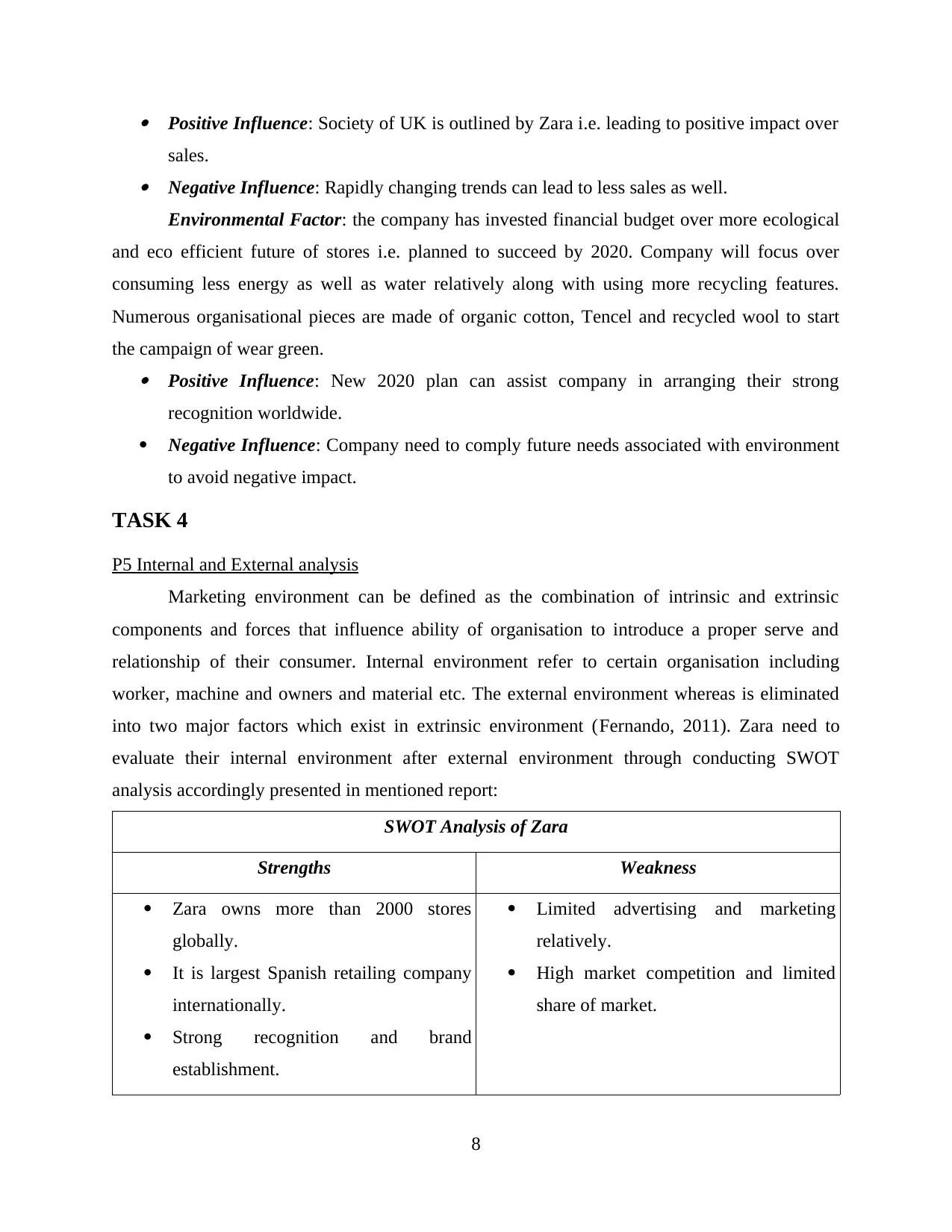
Positive Influence: Society of UK is outlined by Zara i.e. leading to positive impact over
sales. Negative Influence: Rapidly changing trends can lead to less sales as well.
Environmental Factor: the company has invested financial budget over more ecological
and eco efficient future of stores i.e. planned to succeed by 2020. Company will focus over
consuming less energy as well as water relatively along with using more recycling features.
Numerous organisational pieces are made of organic cotton, Tencel and recycled wool to start
the campaign of wear green. Positive Influence: New 2020 plan can assist company in arranging their strong
recognition worldwide.
Negative Influence: Company need to comply future needs associated with environment
to avoid negative impact.
TASK 4
P5 Internal and External analysis
Marketing environment can be defined as the combination of intrinsic and extrinsic
components and forces that influence ability of organisation to introduce a proper serve and
relationship of their consumer. Internal environment refer to certain organisation including
worker, machine and owners and material etc. The external environment whereas is eliminated
into two major factors which exist in extrinsic environment (Fernando, 2011). Zara need to
evaluate their internal environment after external environment through conducting SWOT
analysis accordingly presented in mentioned report:
SWOT Analysis of Zara
Strengths Weakness
Zara owns more than 2000 stores
globally.
It is largest Spanish retailing company
internationally.
Strong recognition and brand
establishment.
Limited advertising and marketing
relatively.
High market competition and limited
share of market.
8
sales. Negative Influence: Rapidly changing trends can lead to less sales as well.
Environmental Factor: the company has invested financial budget over more ecological
and eco efficient future of stores i.e. planned to succeed by 2020. Company will focus over
consuming less energy as well as water relatively along with using more recycling features.
Numerous organisational pieces are made of organic cotton, Tencel and recycled wool to start
the campaign of wear green. Positive Influence: New 2020 plan can assist company in arranging their strong
recognition worldwide.
Negative Influence: Company need to comply future needs associated with environment
to avoid negative impact.
TASK 4
P5 Internal and External analysis
Marketing environment can be defined as the combination of intrinsic and extrinsic
components and forces that influence ability of organisation to introduce a proper serve and
relationship of their consumer. Internal environment refer to certain organisation including
worker, machine and owners and material etc. The external environment whereas is eliminated
into two major factors which exist in extrinsic environment (Fernando, 2011). Zara need to
evaluate their internal environment after external environment through conducting SWOT
analysis accordingly presented in mentioned report:
SWOT Analysis of Zara
Strengths Weakness
Zara owns more than 2000 stores
globally.
It is largest Spanish retailing company
internationally.
Strong recognition and brand
establishment.
Limited advertising and marketing
relatively.
High market competition and limited
share of market.
8
Paraphrase This Document
Need a fresh take? Get an instant paraphrase of this document with our AI Paraphraser
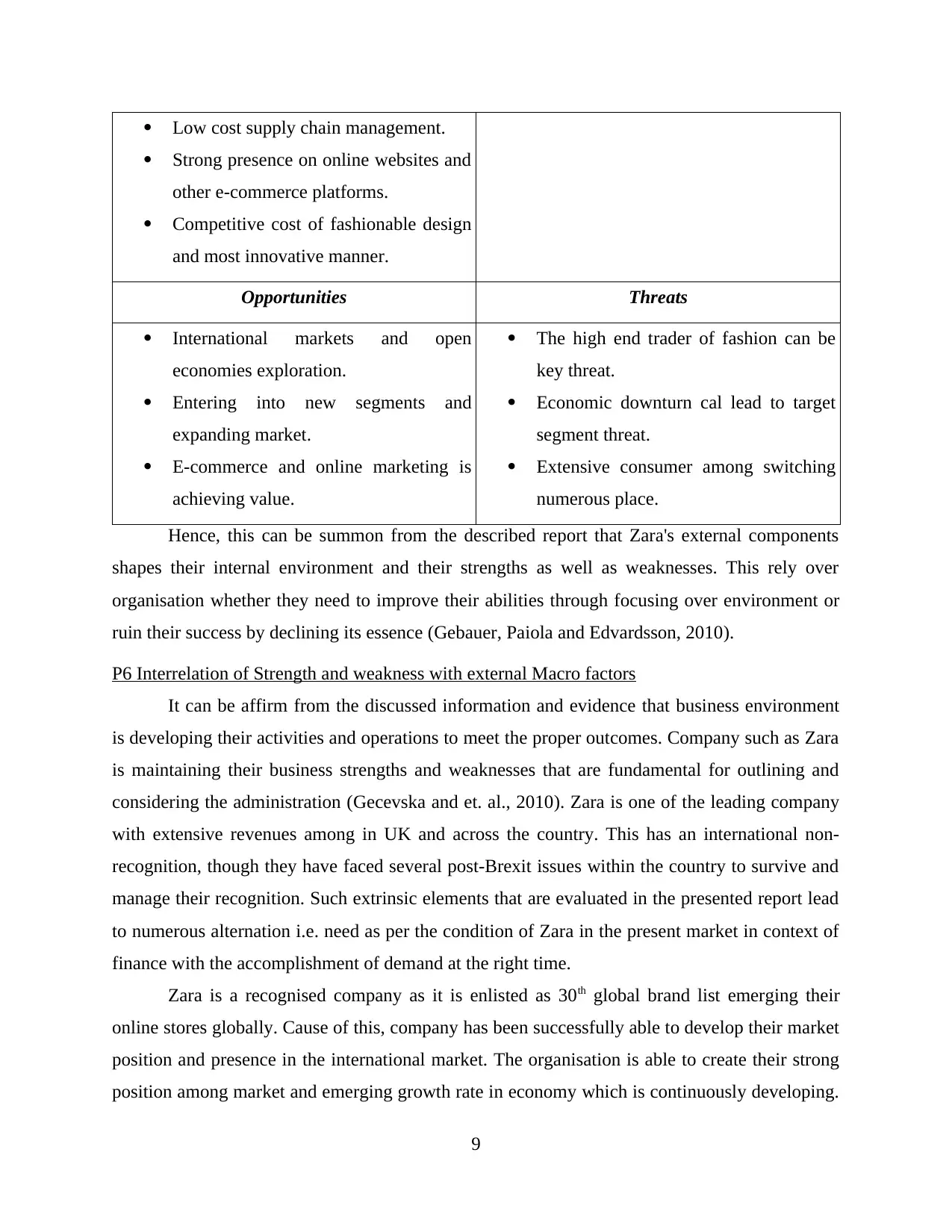
Low cost supply chain management.
Strong presence on online websites and
other e-commerce platforms.
Competitive cost of fashionable design
and most innovative manner.
Opportunities Threats
International markets and open
economies exploration.
Entering into new segments and
expanding market.
E-commerce and online marketing is
achieving value.
The high end trader of fashion can be
key threat.
Economic downturn cal lead to target
segment threat.
Extensive consumer among switching
numerous place.
Hence, this can be summon from the described report that Zara's external components
shapes their internal environment and their strengths as well as weaknesses. This rely over
organisation whether they need to improve their abilities through focusing over environment or
ruin their success by declining its essence (Gebauer, Paiola and Edvardsson, 2010).
P6 Interrelation of Strength and weakness with external Macro factors
It can be affirm from the discussed information and evidence that business environment
is developing their activities and operations to meet the proper outcomes. Company such as Zara
is maintaining their business strengths and weaknesses that are fundamental for outlining and
considering the administration (Gecevska and et. al., 2010). Zara is one of the leading company
with extensive revenues among in UK and across the country. This has an international non-
recognition, though they have faced several post-Brexit issues within the country to survive and
manage their recognition. Such extrinsic elements that are evaluated in the presented report lead
to numerous alternation i.e. need as per the condition of Zara in the present market in context of
finance with the accomplishment of demand at the right time.
Zara is a recognised company as it is enlisted as 30th global brand list emerging their
online stores globally. Cause of this, company has been successfully able to develop their market
position and presence in the international market. The organisation is able to create their strong
position among market and emerging growth rate in economy which is continuously developing.
9
Strong presence on online websites and
other e-commerce platforms.
Competitive cost of fashionable design
and most innovative manner.
Opportunities Threats
International markets and open
economies exploration.
Entering into new segments and
expanding market.
E-commerce and online marketing is
achieving value.
The high end trader of fashion can be
key threat.
Economic downturn cal lead to target
segment threat.
Extensive consumer among switching
numerous place.
Hence, this can be summon from the described report that Zara's external components
shapes their internal environment and their strengths as well as weaknesses. This rely over
organisation whether they need to improve their abilities through focusing over environment or
ruin their success by declining its essence (Gebauer, Paiola and Edvardsson, 2010).
P6 Interrelation of Strength and weakness with external Macro factors
It can be affirm from the discussed information and evidence that business environment
is developing their activities and operations to meet the proper outcomes. Company such as Zara
is maintaining their business strengths and weaknesses that are fundamental for outlining and
considering the administration (Gecevska and et. al., 2010). Zara is one of the leading company
with extensive revenues among in UK and across the country. This has an international non-
recognition, though they have faced several post-Brexit issues within the country to survive and
manage their recognition. Such extrinsic elements that are evaluated in the presented report lead
to numerous alternation i.e. need as per the condition of Zara in the present market in context of
finance with the accomplishment of demand at the right time.
Zara is a recognised company as it is enlisted as 30th global brand list emerging their
online stores globally. Cause of this, company has been successfully able to develop their market
position and presence in the international market. The organisation is able to create their strong
position among market and emerging growth rate in economy which is continuously developing.
9
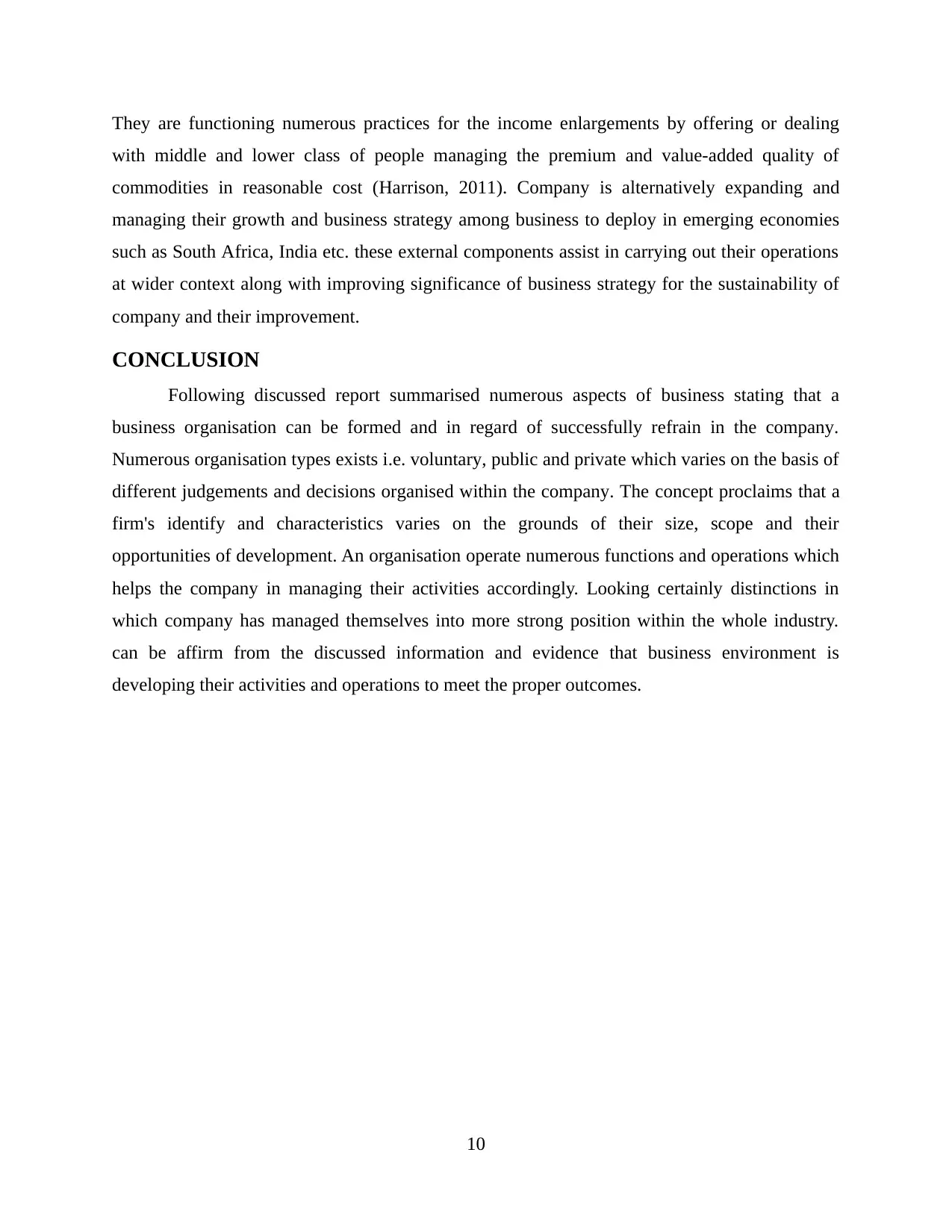
They are functioning numerous practices for the income enlargements by offering or dealing
with middle and lower class of people managing the premium and value-added quality of
commodities in reasonable cost (Harrison, 2011). Company is alternatively expanding and
managing their growth and business strategy among business to deploy in emerging economies
such as South Africa, India etc. these external components assist in carrying out their operations
at wider context along with improving significance of business strategy for the sustainability of
company and their improvement.
CONCLUSION
Following discussed report summarised numerous aspects of business stating that a
business organisation can be formed and in regard of successfully refrain in the company.
Numerous organisation types exists i.e. voluntary, public and private which varies on the basis of
different judgements and decisions organised within the company. The concept proclaims that a
firm's identify and characteristics varies on the grounds of their size, scope and their
opportunities of development. An organisation operate numerous functions and operations which
helps the company in managing their activities accordingly. Looking certainly distinctions in
which company has managed themselves into more strong position within the whole industry.
can be affirm from the discussed information and evidence that business environment is
developing their activities and operations to meet the proper outcomes.
10
with middle and lower class of people managing the premium and value-added quality of
commodities in reasonable cost (Harrison, 2011). Company is alternatively expanding and
managing their growth and business strategy among business to deploy in emerging economies
such as South Africa, India etc. these external components assist in carrying out their operations
at wider context along with improving significance of business strategy for the sustainability of
company and their improvement.
CONCLUSION
Following discussed report summarised numerous aspects of business stating that a
business organisation can be formed and in regard of successfully refrain in the company.
Numerous organisation types exists i.e. voluntary, public and private which varies on the basis of
different judgements and decisions organised within the company. The concept proclaims that a
firm's identify and characteristics varies on the grounds of their size, scope and their
opportunities of development. An organisation operate numerous functions and operations which
helps the company in managing their activities accordingly. Looking certainly distinctions in
which company has managed themselves into more strong position within the whole industry.
can be affirm from the discussed information and evidence that business environment is
developing their activities and operations to meet the proper outcomes.
10
⊘ This is a preview!⊘
Do you want full access?
Subscribe today to unlock all pages.

Trusted by 1+ million students worldwide
1 out of 13
Related Documents
Your All-in-One AI-Powered Toolkit for Academic Success.
+13062052269
info@desklib.com
Available 24*7 on WhatsApp / Email
![[object Object]](/_next/static/media/star-bottom.7253800d.svg)
Unlock your academic potential
Copyright © 2020–2025 A2Z Services. All Rights Reserved. Developed and managed by ZUCOL.

![Business and the Business Environment: Report for [University Name]](/_next/image/?url=https%3A%2F%2Fdesklib.com%2Fmedia%2Fimages%2Fbe%2F38fa8050ce8f491d8760aff1b89116bc.jpg&w=256&q=75)



